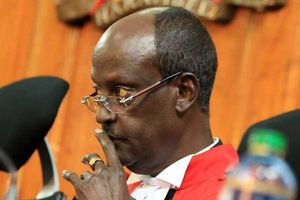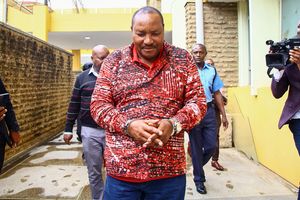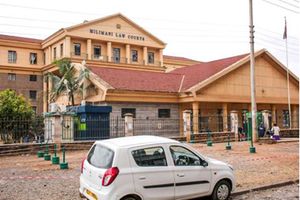Premium
Africa remains excluded from climate change financing

A herdsboy walks on a dry dam at Lerata in Samburu East in this picture taken on July 15, 2021.
Jean-Paul Adam, Seychelles former Foreign Affairs minister, is the director of Technology, Climate Change and Natural Resources Division at the UN Economic Commission for Africa. He spoke to Wanjohi Kabukuru for Africa Renewal about Africa’s priorities at the global climate talks (COP26) taking place in Glasgow during 31 October to 12 November 2021:
Africa Renewal: What are Africa’s priorities at the COP26 and why?
Jean-Paul Adam: Climate finance, technology transfer and capacity building are indeed the priorities that are being put forward to COP26. The finance conversation is a big one because it is, in a sense, the prerequisite for many of the other things to happen, including technology transfer. The mobilisation of finance to tackle climate change, particularly for adaptation, is as urgent as ever.
African advocacy to ensure that previous commitments are honoured will be critical. Ultimately, we cannot divorce the climate resilience agenda from the development agenda. We cannot have one without the other. However, the biggest missing piece in the puzzle is up-front financing.
Developed countries pledged US$100 billion per year by 2020 for climate action in developing countries. Where are we on this?
It is frankly absurd that we have trillions of dollars being mobilised in pandemic-related stimulus but the $100 billion is yet to be paid, and yet as a percentage of the $20 trillion mobilised by developed countries to tackle Covid-19 it is frankly negligible.
The $100 billion is only a portion of what is needed to deal with climate change, and it should be reviewed urgently to match the extent of the financing gap. Even with more innovative financing models being undertaken, the new financing instruments should not replace the promised $100 billion per year.
We must also use this moment in history to redefine how we look at development - where we look beyond GDP per capita, and address the underlying factors that affect vulnerability of countries. This is particularly relevant for Small Island Developing States (SIDS).
African countries are taking proactive stances and committing to move to renewable energy pathways and invest in their own resilience. Many countries are already net positive and absorb more emissions than they create. African countries are ambitious in terms of the low carbon development models they wish to adopt. What is missing is the investment to unlock this opportunity.
One of the key elements of COP26 is that Africa remains excluded from a lot of the financing available under climate change. Private markets are insufficiently developed to channel much needed investment into African climate resilience projects, and this would be a key part of the solution.
Given African countries’ debt burden, what other options are there to boost financing?
Debt issues are a challenge in the Covid-19 pandemic context where fiscal space for all African countries continues to be constrained, and countries are unable to service their debt with diminishing revenues.
However, opportunities are emerging for innovative finance. There is a need to have private sector investments as part of the solution bringing in innovative financial mechanisms such as blended finance, green and blue bonds, and debt swaps, which can leverage limited public resources to mobilise huge investments needed for climate action. For instance, we welcome the recent comments from the World Bank indicating interest in developing frameworks for debt-for-climate adaptation swaps [debt relief in exchange for countries taking climate action].
Africa’s economy of the future must be resilient to risks of further climate change and ecological damage. By prioritising nature-based solutions and advocating for a fair developmental price for carbon at COP26 in Glasgow, there is opportunity to mobilise further resources for Africa’s green and blue economy.
Can you speak more about the green and blue bonds?
We at the UN Economic Commission for Africa are working with partners to further develop financing opportunities through market-based mechanisms including through green or blue bonds. African countries need additional mechanisms to raise finance in addition to the $100 billion, if it is provided. It is essential that the $100 billion is mobilised, but we should also understand that this is a starting point, and that the real needs go far beyond this figure.
Green and blue bonds are opportunities that have been used in developed markets for many years but unfortunately, Africa today has less than 1 per cent of the green and blue bond market globally. Properly tapping into this opportunity for market-based investments can turn billions into trillions.
Some countries have successfully issued green and blue bonds. Egypt issued a bond in renewable energy in 2020 and Seychelles issued a blue bond in 2018. The idea is to provide financing at cheaper rates linked to investment in climate resilience.
Blue bonds are associated with the blue economy and oceans. How are they linked to climate change action and sustainable development?
Climate change has taught us great lessons about the oceans. We cannot just say ‘let us take everything and exploit it’. Many countries have experienced coral bleaching which has an immediate impact on fish stocks.
A warming ocean affects the migration of key species such as tuna. The sea is not just a space for exploitation, it is a space for development. It is a space to connect countries, it is about trade routes, connectivity, environmental protection, tourism, natural resources, fisheries and the entire ocean view. This is the blue economy.
The concepts of a green economy or a blue economy are precisely aimed at ensuring that the health of the natural eco-system is properly factored into the economic activities which generate wealth.
For us, the blue economy is about creating a new economic paradigm for African countries - beyond extraction for export - and rather about sustainably building value chains that are grounded in astute management of the oceanic natural resources. There are many opportunities in the sea and the blue economy is a key part of sustainability. In a sense, the blue economy approach allows Africa to reclaim its oceans.
The race to net-zero places emphasis on a ‘just transition’. What does this mean and how will it affect Africa?
The ‘just transition’ simply means that we have to recognize that Africa is starting from a lower base in terms of the move towards the low-carbon economy. Africa is not yet industrialised, meaning that the changes that are needed may actually see more disruptions in society. We should not make the most vulnerable people pay. We have to take an approach that is pro-development, pro-poor and which ultimately allows the maximum number of people to be able to exit poverty and have a good quality of life.
The priority for Africa’s industrialisation is access to electricity. The good news is that renewable energy is the cheapest form of energy generation available and therefore it makes sense for Africa to invest in renewables. Nevertheless, we must recognize that in certain circumstances, improving base generation capacity may require additional investment in fossil fuels to allow increased renewables or be brought online.
A ‘just transition’ means we deal with poverty as number one priority. By dealing with poverty, we will provide the solution for low carbon development.
Interview courtesy of Africa Renewal





